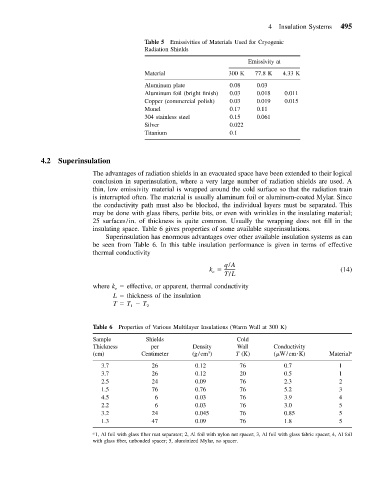Page 506 - Mechanical Engineers' Handbook (Volume 4)
P. 506
4 Insulation Systems 495
Table 5 Emissivities of Materials Used for Cryogenic
Radiation Shields
Emissivity at
Material 300 K 77.8 K 4.33 K
Aluminum plate 0.08 0.03
Aluminum foil (bright finish) 0.03 0.018 0.011
Copper (commercial polish) 0.03 0.019 0.015
Monel 0.17 0.11
304 stainless steel 0.15 0.061
Silver 0.022
Titanium 0.1
4.2 Superinsulation
The advantages of radiation shields in an evacuated space have been extended to their logical
conclusion in superinsulation, where a very large number of radiation shields are used. A
thin, low emissivity material is wrapped around the cold surface so that the radiation train
is interrupted often. The material is usually aluminum foil or aluminum-coated Mylar. Since
the conductivity path must also be blocked, the individual layers must be separated. This
may be done with glass fibers, perlite bits, or even with wrinkles in the insulating material;
25 surfaces/in. of thickness is quite common. Usually the wrapping does not fill in the
insulating space. Table 6 gives properties of some available superinsulations.
Superinsulation has enormous advantages over other available insulation systems as can
be seen from Table 6. In this table insulation performance is given in terms of effective
thermal conductivity
q/A
k (14)
e
T/L
where k effective, or apparent, thermal conductivity
e
L thickness of the insulation
T T T 2
1
Table 6 Properties of Various Multilayer Insulations (Warm Wall at 300 K)
Sample Shields Cold
Thickness per Density Wall Conductivity
3
(cm) Centimeter (g/cm ) T (K) ( W/cm K) Material a
3.7 26 0.12 76 0.7 1
3.7 26 0.12 20 0.5 1
2.5 24 0.09 76 2.3 2
1.5 76 0.76 76 5.2 3
4.5 6 0.03 76 3.9 4
2.2 6 0.03 76 3.0 5
3.2 24 0.045 76 0.85 5
1.3 47 0.09 76 1.8 5
a
1, Al foil with glass fiber mat separator; 2, Al foil with nylon net spacer; 3, Al foil with glass fabric spacer; 4, Al foil
with glass fiber, unbonded spacer; 5, aluminized Mylar, no spacer.

